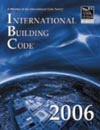| SECTION 2606 LIGHT-TRANSMITTING
PLASTICS
2606.1 General. The provisions
of this section and Sections 2607 through
2611 shall govern the quality and methods
of application of light-transmitting plastics for use as light-transmitting
materials in buildings and structures. Foam plastics shall
comply with Section 2603. Light-transmitting
plastic materials that meet the other code requirements for
walls and roofs shall be permitted to be used in accordance
with the other applicable chapters of the code.
2606.2 Approval for use.
Sufficient technical data shall be submitted to substantiate
the proposed use of any light-transmitting material, as approved
by the building official and subject to the requirements of
this section.
2606.3 Identification. Each
unit or package of light-transmitting plastic shall be identified
with a mark or decal satisfactory to the building official,
which includes identification as to the material classification.
2606.4 Specifications.
Light-transmitting plastics, including thermoplastic, thermosetting
or reinforced thermosetting plastic material, shall have a
self-ignition temperature of 650°F (343°C) or greater where
tested in accordance with ASTM D 1929; a smoke-developed index
not greater than 450 where tested in the manner intended for
use in accordance with ASTME84, or not greater than 75 where
tested in the thickness intended for use in accordance with
ASTM D 2843 and shall conform to one of the following combustibility
classifications:
Class CC1: Plastic materials
that have a burning extent of 1 inch (25 mm) or less where
tested at a nominal thickness of 0.060 inch (1.5 mm), or in
the thickness intended for use, in accordance with ASTM D
635,
Class CC2: Plastic materials
that have a burning rate of 2.5 inches per minute (1.06 mm/s)
or less where tested at a nominal thickness of 0.060 inch
(1.5 mm), or in the thickness intended for use, in accordance
with ASTM D 635.
2606.5 Structural requirements.
Light-transmitting plastic materials in their assembly shall
be of adequate strength and durability to withstand the loads
indicated in Chapter 16. Technical data shall be submitted
to establish stresses, maximum unsupported spans and such
other information for the various thicknesses and forms used
as deemed necessary by the building official.
2606.6 Fastening. Fastening
shall be adequate to withstand the loads in Chapter 16. Proper
allowance shall be made for expansion and contraction of light-transmitting
plastic materials in accordance with accepted data on the
coefficient of expansion of the material and other material
in conjunction with which it is employed.
2606.7 Light-diffusing systems.
Unless the building is equipped throughout with an automatic
sprinkler system in accordance with Section
903.3.1.1, light-diffusing systems shall not be installed
in the following occupancies and locations:
1.Group A with an occupant
load of 1,000 or more.
2.Theaters with a stage and
proscenium opening and an occupant load of 700 or more.
3.Group I-2.
4. Group I-3.
5. Exit stairways and exit
passageways.
2606.7.1 Support. Light-transmitting
plastic diffusers shall be supported directly or indirectly
from ceiling or roof construction by use of noncombustible
hangers. Hangers shall be at least No. 12 steel-wire gage
(0.106 inch) galvanized wire or equivalent.
2606.7.2 Installation.
Light-transmitting plastic diffusers shall comply with Chapter
8 unless the light-transmitting plastic diffusers will fall
from the mountings before igniting, at an ambient temperature
of at least 200°F (111°C) below the ignition temperature
of the panels. The panels shall remain in place at an ambient
room temperature of 175°F (79°C) for a period of not less
than 15 minutes.
2606.7.3 Size limitations.
Individual panels or units shall not exceed 10 feet (3048
mm) in length nor 30 square feet (2.79 m2) in
area.
2606.7.4 Fire suppression
system. In buildings that are equipped throughout with
an automatic sprinkler system in accordance with Section
903.3.1.1, plastic light- diffusing systems shall be
protected both above and below unless the sprinkler system
has been specifically approved for installation only above
the light-diffusing system. Areas of light-diffusing systems
that are protected in accordance with this section shall
not be limited.
2606.7.5 Electrical luminaires.
Light-transmitting plastic panels and light-diffuser panels
that are installed in approved electrical luminaires shall
comply with the requirements of Chapter 8 unless the light-transmitting
plastic panels conform to the requirements of Section 2606.7.2.
The area of approved light-transmitting plastic materials
that are used in required exits or corridors shall not exceed
30 percent of the aggregate area of the ceiling in which
such panels are installed, unless the building is equipped
throughout with an automatic sprinkler system in accordance
with Section 903.3.1.1.
2606.8 Partitions. Light-transmitting
plastics used in or as partitions shall comply with the requirements
of Chapters 6 and 8.
2606.9 Bathroom accessories.
Light-transmitting plastics shall be permitted as glazing
in shower stalls, shower doors, bathtub enclosures and similar
accessory units. Safety glazing shall be provided in accordance
with Chapter 24.
2606.10 Awnings, patio covers
and similar structures. Awnings constructed of light-transmitting
plastics shall be constructed in accordance with the provisions
specified in Section 3105 and Chapter
32 for projections. Patio covers constructed of light-transmitting
plastics shall comply with Section 2606. Light-transmitting
plastics used in canopies at motor fuel-dispensing facilities
shall comply with Section 2606, except as modified by Section
406.5.2.
2606.11 Greenhouses. Light-transmitting
plastics shall be permitted in lieu of plain glass in greenhouses.
2606.12 Solar collectors.
Light-transmitting plastic covers on solar collectors having
noncombustible sides and bottoms shall be permitted on buildings
not over three stories in height or 9,000 square feet (836.1
m2) in total floor area, provided the light-transmitting
plastic cover does not exceed 33.33 percent of the roof area
for CC1 materials or 25 percent of the roof area for CC2 materials.
Exception: Light-transmitting
plastic covers having a thickness of 0.010 inch (0.3 mm) or
less or shall be permitted to be of any plastic material provided
the area of the solar collectors does not exceed 33.33 percent
of the roof area.
|

